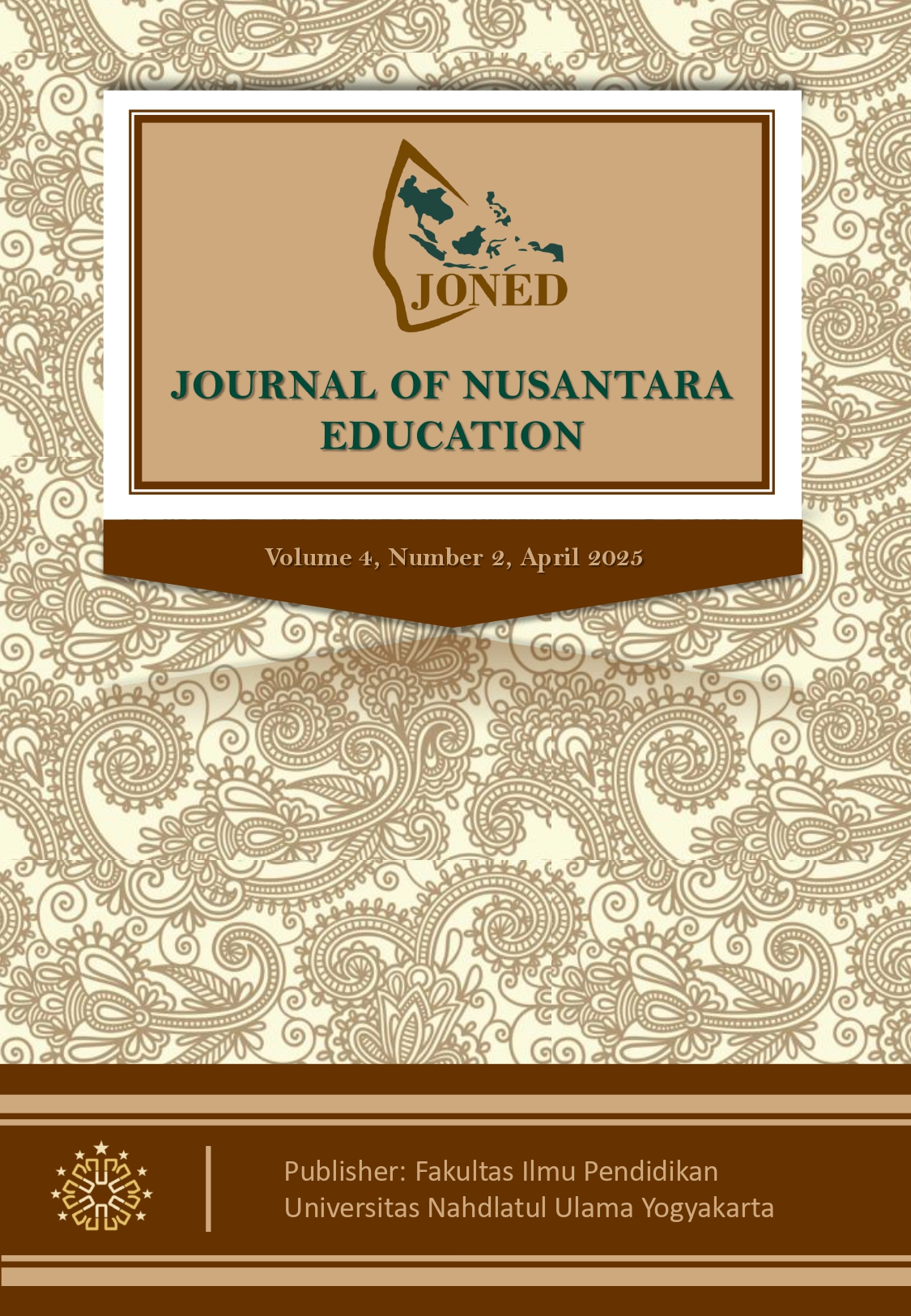Utilizing Zoom as Online Platform for EFL Teaching and Learning: A Systematic Literature Review
DOI:
https://doi.org/10.57176/jn.v4i2.143Keywords:
EFL Teaching, EFL Learning, Online Learning Platform, Zoom MeetingAbstract
Pandemi Covid-19 berdampak pada sistem pendidikan yang menggunakan kelas online. Guru dan siswa terpaksa melakukan pembelajaran jarak jauh dan belajar secara virtual. Salah satu aplikasi online yang banyak digermari adalah Zoom Meeting. Penelitian ini bertujuan untuk menganalisa artikel-artikel terdahulu yang meneliti tentang pemanfaatan Zoom Meeting sebagai platfrom online untuk pengajaran dan pembelajaran Bahasa Inggris sebagai bahasa asing. Studi-studi tersebut menekankan kelebihan dan tantangan dalam penggunaan aplikasi Zoom Meeting khususnya dalam pengajaran dan pembelajaran Bahasa Inggris. Kajian sistematis literatur digunakan untuk mengumpulkan dan menganalisa data dari Google Scholars, Jurnal berputasi, Sage Publication, dan Science Direct selama tiga tahun terakhir dari tahun 2021 hingga tahun 2023. Penelitian-penelitian tersebut dianalisis dengan metode analisis konten untuk menemukan tantangan dan keuntungan pemanfaatan zoom dalam konteks pengajaran dan pembelajaran Bahasa Inggris. Terdapat dua puluh Sembilan artikel yang memenuhi kriteria telah direview yang terdiri dari dua puluh enam artikel penelitian dari Indonesia dan tiga artikel penelitian dari luar negeri. Analisis artikel telah menunjukkan bahwa banyak guru dan siswa Bahasa Inggris yang memandang positif penggunaan Zoom sebagai platform pembelajaran daring terlepas dari beberapa kekurangan yang dirasakan dari penggunaan Zoom tersebut. Platform pembelajaran daring ini telah didukung banyak fitur untuk membuat ruang kelas virtual yang lebih dinteraktif seperti layaknya kelas luring. Sebaliknya, tantangan yang dihadapi dalam implementatsi zoom seperti; jaringan internet, dan penggunaan data.
____________________________________________________________________________________
Covid-19 pandemic affected the education system as an online class. Teachers and students were forced to have distance learning and learn by virtual class. One of the preferred online learning applications is Zoom Meeting. This research aimed to analyse previous research articles about the utilization of Zoom Meeting as an online learning platform for EFL teaching and learning. The studies emphasized the advantages and challenges in the use of Zoom meeting application as online learning platform for EFL teaching and learning. This paper used A systematic literature review method to collect and analyse data from Google Scholar, Reputable Journal, Sage Publication and Science Direct for over the past three years, starting from 2021 to 2023. Those previous articles were analysed with the content analysis method in order to find the challenges and advantages of zoom utilization in EFL teaching and learning context. There were twenty-nine articles that meet the criteria have been reviewed which consists of twenty-six articles from Indonesia and three articles from abroad. The analysis showed that many EFL teachers and students perceived positively in the use of Zoom as an online learning platform, regardless of several perceived drawbacks. This platform has supported by several features to create interactive virtual classrooms. In contrast, the challenges still encountered for zoom implementation such as; internet network, and data usage.
References
Afrijon, C. A., & Rosita, N. (2022). Students’ perception of using Zoom meeting for English microteaching class. Journal of English Language Teaching, 11(3), 357–372.
Aini, Z., Muslem, A., & Marhaban, S. (2021). Investigating students’ motivation and problems towards the use of Zoom platform in English teaching and learning process during the COVID-19 pandemic. English Education Journal, 12(4), 613–630.
Akanda, F., & Suchona, I. J. (2024). Zoom as a teaching tool to enhance students’ listening and speaking skills: Teachers’ and students’ perceptions. IUBAT Review – A Multidisciplinary Academic Journal, 7(1), 202–217. https://doi.org/10.3329/iubatr.v7i1.7466
Alfadda, H. A., & Mahdi, H. S. (2021). Measuring students’ use of Zoom application in language course based on the Technology Acceptance Model (TAM). Journal of Psycholinguistic Research, 50(1), 1–18. https://doi.org/10.1007/s10936-020-09752-1
Amir, F., & Anggitasari, A. (2021). The using communicative language teaching in the online class through SoundCloud, Zoom, and Google Classroom applications. Aplinesia (Journal of Applied Linguistics Indonesia), 5(2), 29–33.
Amumpuni, R. S., Hartono, R., Rukmini, D., & Haryanti, R. P. (2021). Teaching reading using Zoom: Students’ perception of reading class through Zoom. International Conference on Science, Education, and Technology (ISET). https://proceeding.unnes.ac.id/index.php/iset
Archibald, M. M., Ambagtsheer, R. C., Casey, M. G., & Lawless, M. (2019). Using Zoom videoconferencing for qualitative data collection: Perceptions and experiences of researchers and participants. International Journal of Qualitative Methods, 18, 1–8. https://doi.org/10.1177/1609406919874596
Arkoful, V., & Abaidoo, N. (2014). The role of e-learning, the advantages, and disadvantages of its adoption in higher education. International Journal of Education and Research, 2(12). www.ijern.com
Atikah, D., & Nurwijayanti. (2022). EFL learners’ experiences in using Zoom meeting during COVID-19 outbreak. Al Lughawiyaat: Jurnal Bahasa dan Pendidikan Bahasa, 3(1).
Bahtiar, I. R. (2021). Student perceptions of the use of Google Classroom and Zoom in writing skills lecturers during the COVID-19 pandemic. Jurnal Educatio, 7(3), 625–631. https://doi.org/10.31949/educatio.v7i3.1101
Bailenson, J. N. (2021). Nonverbal overload: A theoretical argument for the causes of Zoom fatigue. Technology, Mind and Behavior, 2(1). https://doi.org/10.1037/tmb0000030
Barbour, M. K., Siko, J., Gross, E., & Waddell, K. (2013). Virtually unprepared: Examining the preparation of K–12 online teachers. In Z. L. Berge & T. Clark (Eds.), Teacher education programs and online learning tools: Innovations in teacher preparation (pp. 60–81).
Barbour, M. K., LaBonte, R., Kelly, K., Hodges, C., Moore, S., Lockee, B., Trust, T., Bond, A., & Hill, P. (2020). Understanding pandemic pedagogy: Differences between emergency remote, remote and online teaching. Canadian eLearning Network.
Cheung, A. (2023). Language teaching during a pandemic: A case study of Zoom use by a secondary ESL teacher in Hong Kong. RELC Journal, 54(1), 55–70. https://doi.org/10.1177/0033688220981784
Choukaier, D. (2024). Enhancing English as a foreign language (EFL) instruction through digital teaching platforms: Analysing the impact of Microsoft Teams, Zoom, and Google Meet on communication and participation. Educational Administration: Theory and Practice, 30(6), 2404–2418.
Davis, N., Niederhausers, D., Compton, L., Limdstrom, D., & Schoeny, Z. (2005). Virtual schooling lab practice: Case studies for teacher preparation. In Proceedings of the International Conference of the Society for Information Technology and Teacher Education (pp. 342–345).
Davis, N. E., Roblyer, M. D., Charania, A., Ferdig, R., Harms, C., Compton, L. K. L., & Cho, M. O. (2007). Illustrating the “virtual” in virtual schooling: Challenges and strategies for creating real tools to prepare virtual teachers. The Internet and Higher Education, 10(1), 27–39.
De La Varre, C., Keane, J., & Irvin, M. J. (2010). Enhancing online distance education in small rural US schools: A hybrid, learner centred model. Australasian Journal of Educational Technology, 26(8), 193–205. https://doi.org/10.3402/rlt.v18i3.1073
Dewi, A. K., & Anugerahwati, M. (2023). The implementation of Zoom meeting as teaching instrument for speaking classes in Profitable English Course. In The Annual International Conference on Education (Vol. 1, pp. 131–141).
Dhawan, S. (2020). Online learning: A panacea in the time of COVID-19 crisis. Journal of Educational Technology Systems, 49(1), 5–22. https://doi.org/10.1177/004723952094018
Fitria, T. N. (2021). Students’ perception toward the implementation of synchronous learning during COVID-19 pandemic in English language teaching (ELT). E-Structural, 4(1). http://publikasi.dinus.ac.id/index.php/estructural
Friend, B., & Johnston, S. (2005). Florida Virtual School: A choice for all students. In Z. L. Berge & T. Clark (Eds.), Virtual schools: Planning for success (pp. 97–117). Teachers College Press.
Fujiono, Paulina, Hidayat, N., & Khaja, F. N. B. M. (2021). Impact on distance learning through Zoom application and WhatsApp group on students’ attitude and English aptitude: A case study on students of ICT due to COVID-19 outbreak. Kontribusia, 4(2).
Garini, W. (2022). Undergraduate students’ voices of learning English through online application: Zoom meeting discussion. JOLLT Journal of Language and Language Teaching, 10(2), 276–284.
Gladovic, P., Deretic, N., & Draskovic, D. (2020). Video conferencing and its application in education. JTTTP – Journal of Traffic and Transport Theory and Practice, 5. https://doi.org/10.7251/JTTTP2001045G
Gunawan, G., Kristiawan, M., Risdianto, E., & Monicha, R. E. (2021). Application of the Zoom meeting application in online learning during the pandemic. Education Quarterly Reviews, 4(2). The Asian Institute of Research.
Halim, S. (2022). Students Perception towards English Online Classroom Via Zoom during the COVID-19 Pandemic. IDEAS Journal of Language Teaching and Learning, Linguistic and Literature, Vol.10, No.1, pp.1017-1026
Hasnidar. (2020). Students' Perceptions of using Online Learning Materials.
Hastomo. T., Marcela, E.D. (2021). Video Conference in Teaching EFL: A Case Study of Using Zoom. LENTERA: Jurnal Ilmiah Kependidikan, 14(1), pp.125-132
Hazelrigg. N. (2019). Survey: Nearly Half of Students Distracted by Technology. Inside Higher Ed.
Hodges, C., Moore, S., Lockee, B., Trust, T., & Bond, A. (2020). “The Difference Between Emergency Remote Teaching and Online Learning. Educause Review, 27, 1-12.
Kaniadewi, N. (2022). Students’ Perceptions in The Utilization of Zoom Video Conferencing on Speaking Ability in Distance Learning. JELTL (Journal of English Language Teaching and Linguistics), Vol. 7(3). DOI:https://dx.doi.org/10.21462/jeltl. 7i3.891
Kohnke, L. Moorhouse, B.L. (2022). Facilitating Synchronous Online Language Learning through Zoom. RELC Journal, Vol. 53(1) 296-301. Sage Publication.
Lee, A.R. (2021). Breaking Through Digital Barriers: Exploring EFL Students’ View of Zoom Breakout Room Experiences. Korean Journal of English Language and Linguistics, Vol.21, June 2021, pp.510-524
Martin, F., Polly. D., & Rizhaupt, A. (2020). Bichronous Online Learning: Blending Asynchronous and Synchronous Online Learning. EDUCAUSE Review.
Maskana, N., Ilma, R., Manalulaili. (2022). Zoom Cloud Meetings: Online Learning Media in Listening. English Franca: Academic Journal of English Language and Education, Vol.6, No.2, 2022. DOI: 10.29240/ef.v612.5442
Meiniawati, E., Purnawingrum, P.W., Setianingrum, H.W., Alawiyah, S., Nurmalia, L., Dewi, N, Sulistyawati, M.E.S., Lestari, V.L. (2021). Students’ Metacognitive Strategy Pattern in English Academic Writing Learning Using Zoom. Al Ishlah: Jurnal Pendidikan, June 2021, Vol.13(1), pages 610-616
Mu’awanah, N. Sumardi, Suparno. (2021). ELT In a Globalized World: The Boundaries and Beyond. Proceeding AISELT (Annual International Seminar on English Language Teaching) 6(1) (2021) 191-204.
Mu’awanah, N. Sumardi., Suparno. (2021). Using Zoom to Support English Learning during Covid-19 Pandemic: Strengths and Challenges. Jurnal Ilmiah Sekolah Dasar, Vol.5, No.2,pp.222-230. https://ejournal.undiksha.ac.id/index. hp/JISD/index
Nawir, E. (2021). The Role of Pedagogical Grammar in English Language Teaching as Second and or Foreign Language Through E-learning Platform: Zoom Meeting in Pandemic Era. 4th English Language and Literature International Conference (ELLiC) Proceedings Vol. 4, 2021.
Ningsih, F.R., Dewi. U., Hamidah, S. (2023). Postgraduate Students’ Perceptions of Using the Zoom Application in EFL Online Class. Language Circle: Journal of Language and Literature 18(1) ISSN 1858-0165.= http://journal.unnes.ac.id
Nuraziza, N., Oktaviani, L., Sari, F. M. (2021). EFL Learners’ Perceptions on ZOOM Application in the Online Classes. Jambura Journal of English Teaching and Literature – Vol 2(1), April: 41-51
Nurieva, G. R., & Garaeva, L. M. (2020). Zoom-based Distance Learning of English as a Foreign Language. Journal of Research in Applied Linguistics, 11 (Proceedings of the 7th International Conference on Applied Linguistics Issues (ALI 2020), Saint Petersburg, 13-14 June 2020), 439 -448. DOI:10.22055/rals.2020.16344
Nuryanto, M. (2021). Fostering Success and Motivating EFL Learners Using Zoom Meeting: A Synchronous Learning Strategy. Anglophile Journal, Vol. 1, No. 2, April 2021. ISSN 2746-8631
Octaviani, A.Y. (2021). The Use of Zoom Cloud Meeting for Teaching English Grammar in an Online Class. RETAIN (Research on English Language Teaching in Indonesia) (eJournal) Vol. 9, No.2, pp 83-92. ISSN 2356-2617
Pulham, E. Graham, C. R., & Short, C. R. (2018). Generic Vs Modality-Specific Competencies for K-12 Online and Blended Teaching. Journal of Online Learning Research, 4(1), 33-52.
Purnama, Y. (2021). Teachers’ Obstacles in English Online Learning during COVID 19 Pandemic. Metathesis: Journal of English Language Literature and Teaching Vol 5(2) pp. 228 -239. DOI:10.31002/metathesis.v512.3618
Putri, N.A. Suryaman, M. (2022). Students’ Perception of Using Zoom Meetings for Online Learning in Teaching English Speaking Skills in Times of COVID 19. Elite Journal: International Journal of Education, Language, and Literature, Vol. 2(2) ISSN:2618127(online)https://journal. nnesa.ac.id/in ex.php/elite
Rahayu, D. (2020). Students’ E-learning Experience through a Synchronous Zoom Web Conference System. Journal of ELT Research: The Academic Journal of Studies in English Language Teaching and Learning, 5(1), 68-79. https://doi.org/10/22236/JER_Vol5Iss ue1pp68-79
Rosalina, D., Purnama, Y.I., Tirtanawati, M. R. (2021). Analysis of English Online Learning during Covid-19 Pandemic through Google Meet. Jurnal Pendidikan Edutama.
Sari, A.B.P., Iswahyuni, D. (2021). EFL Speaking Practice Assisted by Zoom Application during COVID-19 Outbreak in Indonesia. JELLT (Journal of English Language and Language Teaching) Vol.5, No.2
Shin, J. K., Borup, J., Barbour, M. K., Velasquez, R. V. Q. (2022). Webinars for English Language Teachers during the Pandemic: Global Perspectives on Transitioning to Remote Online Teaching. AERA Open 8(1) pp. 1-15
Suadi. (2021). Students’ Perceptions of the Use of Zoom and WhatsApp in ELT Amidst COVID-19 Pandemic. SALEE (Study of Applied Linguistic and English Education) Vol. 1, No. 1.DOI: 10.35961/salee.v2i01.212
Souheyla, B. (2021). Zoom Sessions in Distant Learning: Algerian EFL Students’ Perceptions and Attitudes. Arab World English Journal (AWEJ) Special Issue on Covid 19 Challenges. (1)256- 280. DOI:https://dx.doi.org/10/24093/awej/ covid.20
Surkeeva, D., & Azizova, F. (2021). Using ZOOM in Teaching English Grammar. Bulletin of Science and Practice, 7(2),432-435. https://doi.org/10.33619/2414 2948/73/55
Synder, H. (2019). Literature Review as a Research Methodology: An Overview and Guidelines. Journal of Business Research 104 (2019) 333 -339. https://doi.org/10.106/j.jbusres.2019. 7.039
Traxler, J. (2007). Defining, Discussing and Evaluating Mobile Learning: The Moving Ginger Writes and Having Write. The International Review in Open and Distance Learning, 8(2).
Torukwein David-West, B. (2022). Digital Literacy Skills and Utilization of Online Platforms for Teaching by LIS Educators in Universities in Rivers State, Nigeria. International Journal
of Knowledge Content Development
& Technology Vol. 12(4),105.http://dx.doi.org/10.5865/I KCT.2022.12.4.105
Vui, T.T., Bui, D.B.H. (2021). EFL Teaching and Learning via Zoom during COVID-19: Impacts of Students’ Engagement on Vocabulary Range and Reading Comprehension Skills. EFLIJ Vol. 1 Issue 2 September 2021 Special Issue
Yasin, M. I. (2021). Students’ Perception Toward the Use of Zoom for Teaching Speaking. Language-Edu Journal of English Teaching and Learning, Vol.10, No.6
Downloads
Published
How to Cite
Issue
Section
License
Copyright (c) 2025 Suci Utami Armand, Pupung Purnawarman

This work is licensed under a Creative Commons Attribution-ShareAlike 4.0 International License.
You are free to:
- Share — copy and redistribute the material in any medium or format for any purpose, even commercially.
- Adapt — remix, transform, and build upon the material for any purpose, even commercially.
- The licensor cannot revoke these freedoms as long as you follow the license terms.
Under the following terms:
- Attribution — You must give appropriate credit , provide a link to the license, and indicate if changes were made . You may do so in any reasonable manner, but not in any way that suggests the licensor endorses you or your use.
- ShareAlike — If you remix, transform, or build upon the material, you must distribute your contributions under the same license as the original.
- No additional restrictions — You may not apply legal terms or technological measures that legally restrict others from doing anything the license permits.
Notices:
You do not have to comply with the license for elements of the material in the public domain or where your use is permitted by an applicable exception or limitation .
No warranties are given. The license may not give you all of the permissions necessary for your intended use. For example, other rights such as publicity, privacy, or moral rights may limit how you use the material.
















